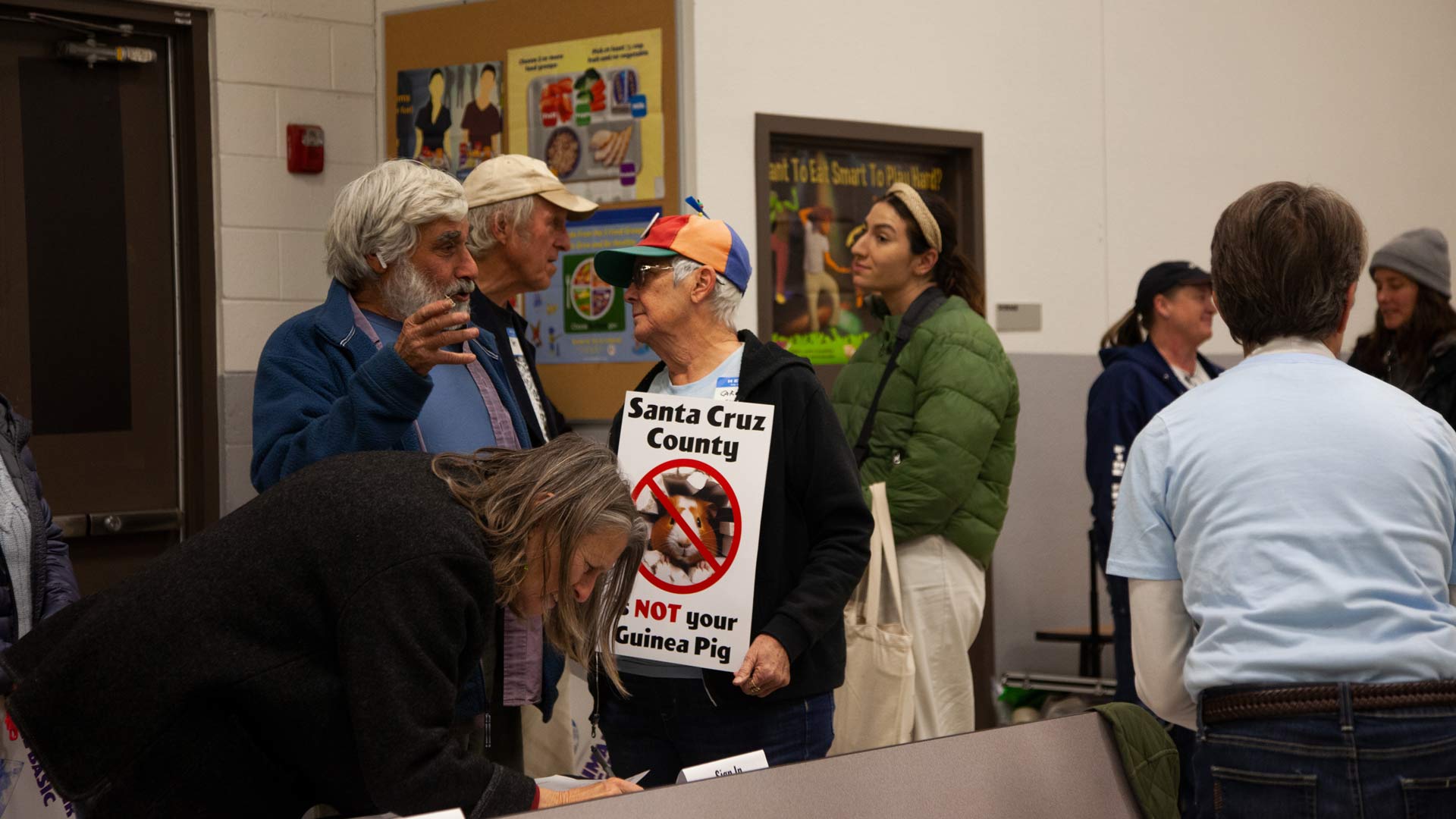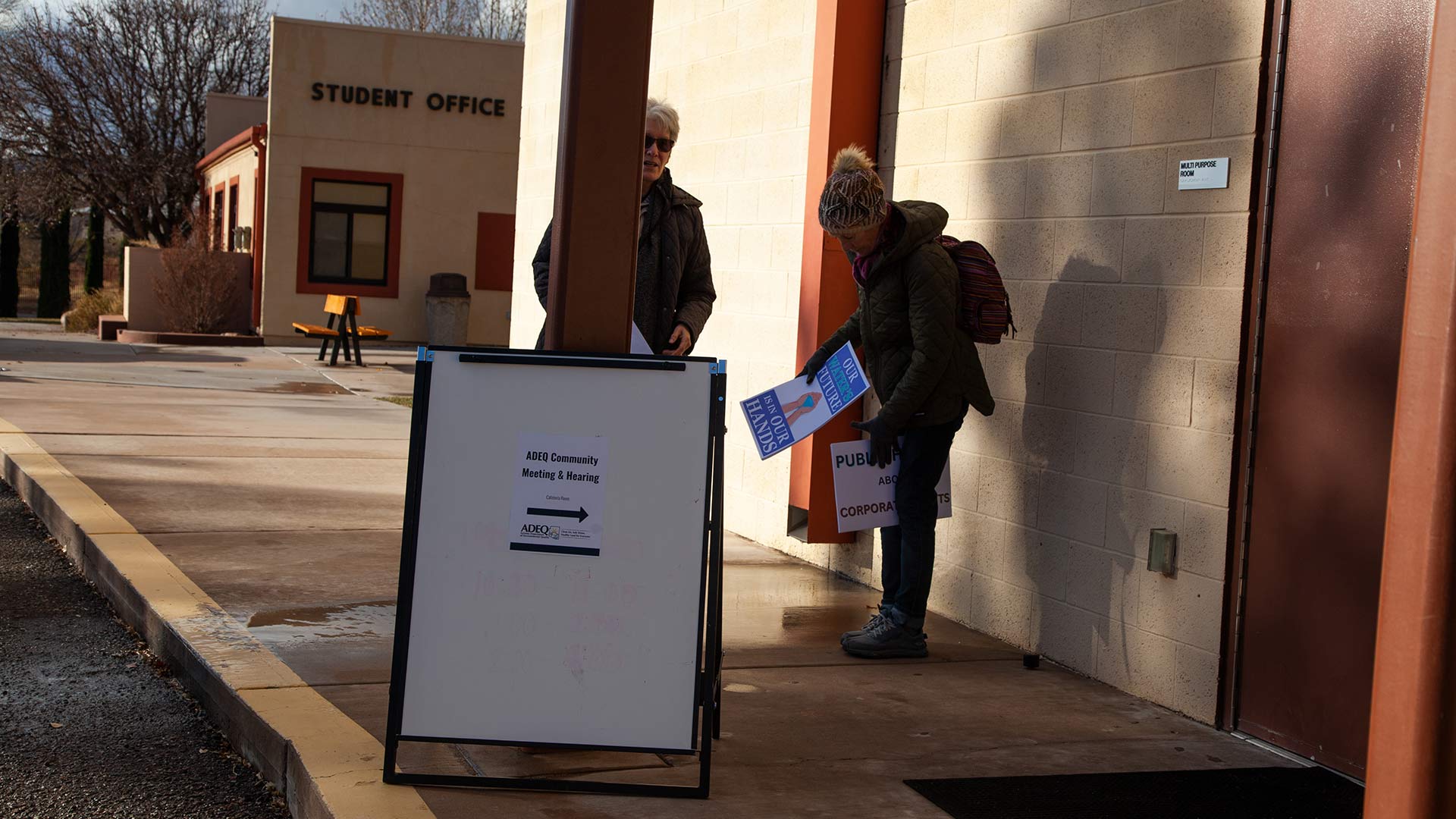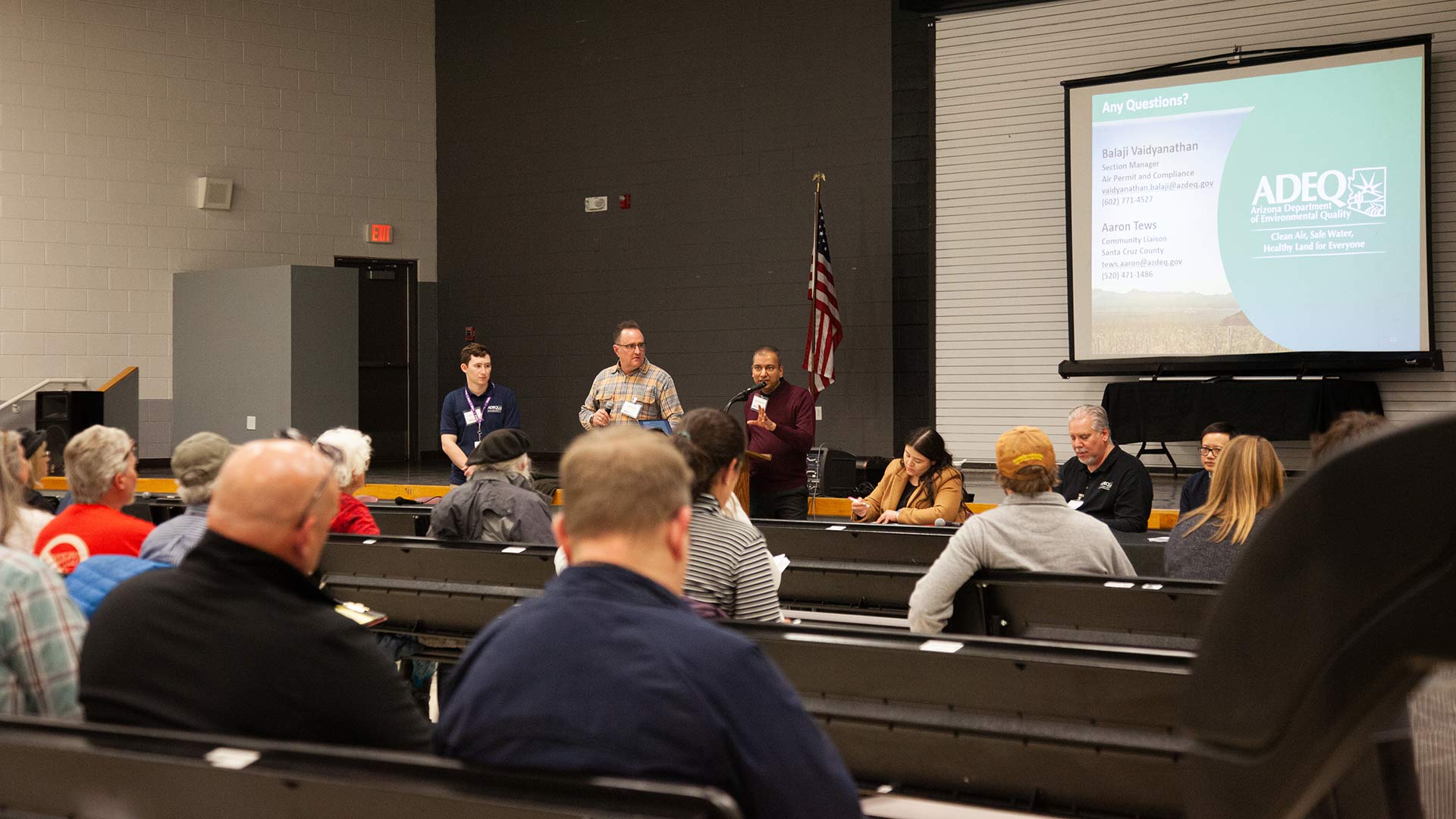 Carolyn Shafer with the Patagonia Area Resource Alliance (PARA) and other Santa Cruz County residents talk after the community meeting and public hearing on Thursday, Jan. 11, hosted by the Arizona Department of Environmental Quality (ADEQ) to discuss pending air quality and water discharge permits for the South32 Hermosa Mine project near Patagonia.
Carolyn Shafer with the Patagonia Area Resource Alliance (PARA) and other Santa Cruz County residents talk after the community meeting and public hearing on Thursday, Jan. 11, hosted by the Arizona Department of Environmental Quality (ADEQ) to discuss pending air quality and water discharge permits for the South32 Hermosa Mine project near Patagonia.
This article has been updated to clarify the air quality permitting process for the South 32 Hermosa project.
The Arizona Department of Environmental Quality (ADEQ) has proposed to issue a new Air Quality Control Permit for the construction and operation of the zinc, silver and manganese Hermosa project near Patagonia.
The mineral exploration and development company South32, has two main deposits; the Taylor deposit is a high-grade zinc-lead-silver deposit, and the Clark deposit is a high-grade manganese-zinc-silver deposit.
According to the draft permit, “The facility’s potential to emit for nitrogen oxides, carbon monoxide, single hazardous air pollutant (acetaldehyde, acrolein, formaldehyde, and methanol), and hazardous air pollutants (HAPs) is greater than major source thresholds.”
Major sources are defined by the Environmental Protection Agency (EPA) as, “a stationary source or group of stationary sources that emit or have the potential to emit 10 tons per year or more of a hazardous air pollutant or 25 tons per year or more of a combination of HAPs.”
The Hermosa facility is classified as a major source of pollution, because of its potential to emit over 100 tons of regulated air pollutants like nitrogen oxides and carbon monoxide and 10 tons of HAPs per year. HAPs differ from common air pollutants because they are known or suspected to cause cancer and other serious health effects including reproductive or birth defects.
At a public hearing held on Thursday, Jan. 11, ADEQ held a community meeting to discuss the science and methodology behind the permitting process.
According to a presentation by ADEQ, “EPA has classified ‘manganese compounds’ as a hazardous air pollutant (HAP), but has not established health-based ambient air quality standards for use in air quality permitting.”
Balaji Vaidyanathan, Air Permits & Compliance Section Manager in the Air Quality Division said, “Under the EPA federal program, there is no federal ambient standard for manganese that we can use in a permitting application.”
 VIEW LARGER Patagonia residents trick into the local high school's cafeteria ahead of a community meeting and public hearing hosted by the Arizona Department of Environmental Quality (ADEQ) to talk about permitting for the South32 Hermosa Mine project on Thursday, Jan. 11, at Patagonia Union High School.
VIEW LARGER Patagonia residents trick into the local high school's cafeteria ahead of a community meeting and public hearing hosted by the Arizona Department of Environmental Quality (ADEQ) to talk about permitting for the South32 Hermosa Mine project on Thursday, Jan. 11, at Patagonia Union High School. During the meeting, Vaidyanathan added that regarding manganese, the question is not about monitoring but rather, “being able to apply a regulatory threshold and openly admitting that the federal program does not have a standard and that is why we have to seek out and rely on a guideline principle from ATSDR.”
ATSDR is the Agency for Toxic Substances and Disease Registry which has a manganese concentration value of 0.3 µg/m³ on a chronic basis.
In order to address the community’s discomfort and concern towards manganese exposure, Vaidyanathan said ADEQ and South32 worked out a process voluntarily, in which the facility evaluated and modeled what the manganese impacts of the project were and how they compared to ATSDR guidelines.
Modeled manganese concentrations were identified as lower than the ATSDR guidelines, the highest modeled annual concentration was 0.216 µg/m³ at the fenceline of the project.
Although there are no regulatory standards for manganese, ADEQ utilized “air dispersion modeling” or mathematical simulations that take into account a variety of variables such as the weather, geography and the facility’s emissions to evaluate the potential environmental impact.
According to ADEQ, “the reported modeling concentrations were based on worst-case scenarios and all maximum modeled concentrations occurred at or near the facility’s fenceline.”
The modeled concentrations near the local community decreased with distance.
The purpose of air quality modeling analysis is, “used to determine that criteria pollutants or hazardous air pollutants emitted from a source will not cause or significantly contribute to a violation of any National Ambient Air Quality Standard (NAAQS), or Prevention of Significant Deterioration (PSD) increment, or Arizona Acute/ Chronic Ambient Air Concentrations (AAAC and CAAC) for listed hazardous air pollutants (HAPs).”
“Criteria pollutants” such as carbon monoxide are considered one of the six principal pollutants that the Hermosa project has the potential to emit, as well as particulate matter, lead, ozone, sulfur dioxide or nitrogen dioxide.
 VIEW LARGER Balaji Vaidyanathan with the Arizona Department of Environmental Quality (ADEQ) answers questions during a community meeting about a pending air quality permit for the South 32 Hermosa Mine project in Patagonia on Thursday, Jan. 11. Residents in the area are primarily concerned about potential negative health outcomes from manganese exposure. The Hermosa Mine looks to source "critical minerals" zinc, manganese, lead and silver from its two main deposits.
VIEW LARGER Balaji Vaidyanathan with the Arizona Department of Environmental Quality (ADEQ) answers questions during a community meeting about a pending air quality permit for the South 32 Hermosa Mine project in Patagonia on Thursday, Jan. 11. Residents in the area are primarily concerned about potential negative health outcomes from manganese exposure. The Hermosa Mine looks to source "critical minerals" zinc, manganese, lead and silver from its two main deposits. Under EPA, the Clean Air Act (CAA) identifies two types of NAAQs: primary, which protects the public including “sensitive populations” such as children, elderly and asthmatics and secondary, which provides public welfare protection and protection against damage to animals, crops, vegetation and decreased visibility.
Manganese compounds are classified as a HAP but EPA has not established federal air quality standards to be used for air quality permitting.
If an air quality permit is granted, it will be valid for five years and subject South32 Hermosa to comply with established contaminant guidelines and random inspections.
Patagonia residents aren’t convinced.
During the question period, many expressed concern about the potential negative health outcomes from manganese exposure, pollution from increased traffic from mining operations and a lack of confidence in South32’s “self-policing practices.”
In response to requests for an extension, the public comment period is now open through Monday, Feb. 26, which will be followed by a formal public hearing.
Once comments have been submitted, the draft permit would then be shared with the EPA, which has a 45 day period for consultation before final action is taken on the permit.
If the draft air quality permit is approved, ADEQ will issue a final permit. If EPA objects to the draft, ADEQ must address and resolve the objections.

By submitting your comments, you hereby give AZPM the right to post your comments and potentially use them in any other form of media operated by this institution.